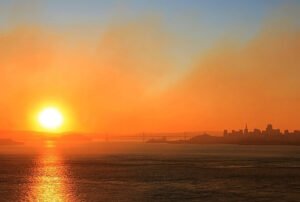
October 3, 2017; Next City
With a campaign that began in 2005, National City in California made headlines as the first city in California to pioneer including environmental justice as part of their comprehensive plan. A year ago, a bill, SB 1000, authored by Senator Connie M. Leyva (D-Chino) and cosponsored by the Center for Community Action and Environmental Justice (CCAEJ) and the California Environmental Justice Alliance (CEJA), was signed into law by California’s Governor Edmund G. (“Jerry”) Brown, Jr.. The law took effect this January. The law requires that California cities address environmental justice in their planning, as the Civic Solutions consultancy indicates, “either through the preparation of a standalone Environmental Justice Element or through the adoption of goals, policies and objectives incorporated into other elements.”
So, as Next City writer Rachel Dovey explains, California cities face several new requirements. Cities must have a comprehensive, long-term plan for development; they must identify disadvantaged communities; and plans must have an environmental justice element that will “identify objectives and policies to reduce the unique or compounded health risks in disadvantaged communities.”
National City’s 155-page plan is now a model for the field and forms a key element of an upcoming toolkit, scheduled to be released by CEJA on October 9th. National City, it would appear, has something to share with its wealthier California brethren (think San Francisco or Santa Monica, for example), which now may have to catch up with their poorer border city cousin.
National City is among the state’s more economically and environmentally disadvantaged cities. According to the San Diego County Department of Health, National City is “home to 32 million pounds of hazardous substances and 870,000 cubic feet of toxic or hazardous gases.” Nearby La Jolla, with a similar population size, had 3.8 million pounds of hazardous gases. As a result, National City has an asthma rate 60 percent higher than the county average, among other environment-related health challenges.
People of color dominate the city’s population. Almost 60 percent are Latinx and a little under 18 percent are Filipino; whites make up about 14 percent of the city’s population. About two-thirds of residents are renters, and nearly a quarter of its residents live below the poverty line.
As Smithsonian Magazine pointed out, “the reality is that low income, diverse areas are often exposed to significantly more environmental pollutants than other socioeconomic groups and neighborhoods. Environmental discrimination is a subset of almost every other kind of prejudice.”
The EPA defines environmental justice as a situation where people have:
Sign up for our free newsletters
Subscribe to NPQ's newsletters to have our top stories delivered directly to your inbox.
By signing up, you agree to our privacy policy and terms of use, and to receive messages from NPQ and our partners.
- the same degree of protection from environmental and health hazards, and
- equal access to the decision-making process to have a healthy environment in which to live, learn, and work.
Unfortunately, after years of ignoring community health and sustainability goals in urban planning, cities have reached a point where having more money buys you not only a nicer but a healthier place to live.
“When you integrate community members who may not have been planners for 10 or 20 years or may not have had access to higher education into the planning process, it creates room for things to be solved in different ways,” notes Carolina Martínez, associate director of policy at the National City-based Environmental Health Coalition.
Urban planning, if done in cooperation with disadvantaged communities, can reduce other elements of injustice as well. For instance, in 2015, Rick Cohen discussed Michelle Alexander’s claim that community-based urban planning can help undo the dynamic of the “New Jim Crow,” a system of incarceration and disenfranchisement that targets Black Americans.
Many cities are slow to do the periodic urban planning updates that would help them more accurately accommodate the needs of residents. “It’s a major undertaking,” Christopher Calfee from the Governor’s Office of Planning and Research told the Orange County Register. “The update takes a long time, and it can be quite resource intensive, and expensive.” We then have a chicken-and-egg situation, where money is inefficiently spent due to outdated information, which then drains the pool of money to spend on updating the data that would improve spending patterns…you get the picture. Some cities in Orange County haven’t updated their plans since the 1970s.
But the toolkit and the National City example provide valuable resources for those who generate the political will to take the plunge. As Dovey writes:
National City’s experience, as well as the other case studies CEJA highlights from Fresno, Jurupa Valley, the Los Angeles region and Richmond, serve as instructive and inspiring examples for other cities hoping to tackle local health inequities. CEJA’s toolkit also helps cities identify disadvantaged areas in their own jurisdictions, understand the requirements of SB 1000 and locate funding sources. It will no doubt be very helpful for California cities—at least the ones that don’t ignore or willfully obstruct state law.
—Erin Rubin













